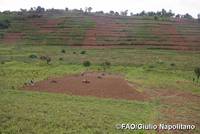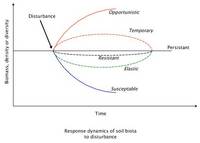Soil Biodiversity, Soil Conservation and Agriculture
Our
agricultural activities exert an important influence on the soil biota,
their activities and diversity. Clearing forested or grassland for
cultivation drastically affects the soil environment and hence reduces
the number and species of soil organisms. The reduction of quantity and
quality of plant residues and the number of higher plants species leads
to a reduction in the range of habitats and foods for soil organisms.
Different types of agricultural practices and systems affect
the soil biota in different ways and the response may be either
positive or negative depending on which part of the soil the biota, e.g.
fungal or bacterial, is affected. For example, organisms which are
sensitive to pH will be affected by the addition of lime; the bacterial:
fungal ratio will be affected by the addition of fertilizers and
manures which alter the C:N ratio as will the effects of tillage.
Tilling the soil will reduce the number of fungal hyphens, because soil
aggregates, which are held together by these hyphens, are broken down.
About 99% of the world's food supply comes ultimately from land-based production with about 50-70% of the land devoted to agriculture.
As the population is estimated to reach 9-10.5 billion by 2050 we
cannot ignore the health of the 'soil organism' if we want to be able to
provide food and feed for increasing consumption and sustain our soil
resources. Modern agricultural methods such as plowing, fertilizer application and pesticides have
often replaced biological soil functions and increased the reliance on
external inputs to maintain productivity, which in the long run is
unsustainable.


No comments:
Post a Comment